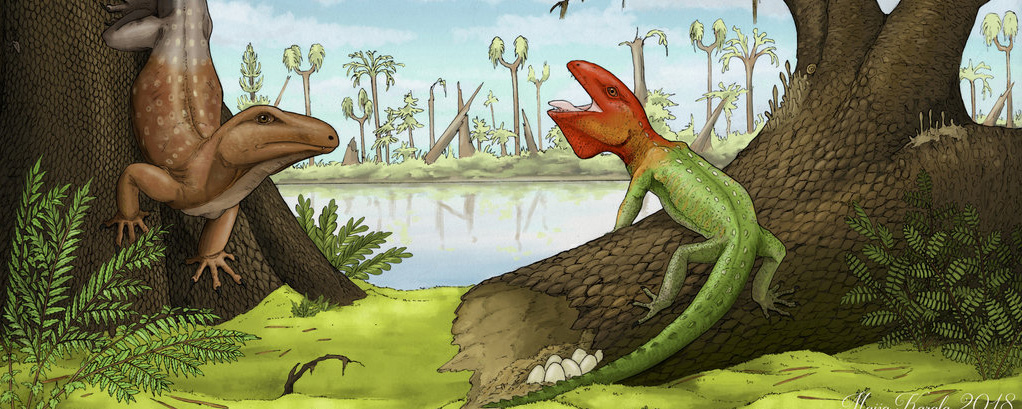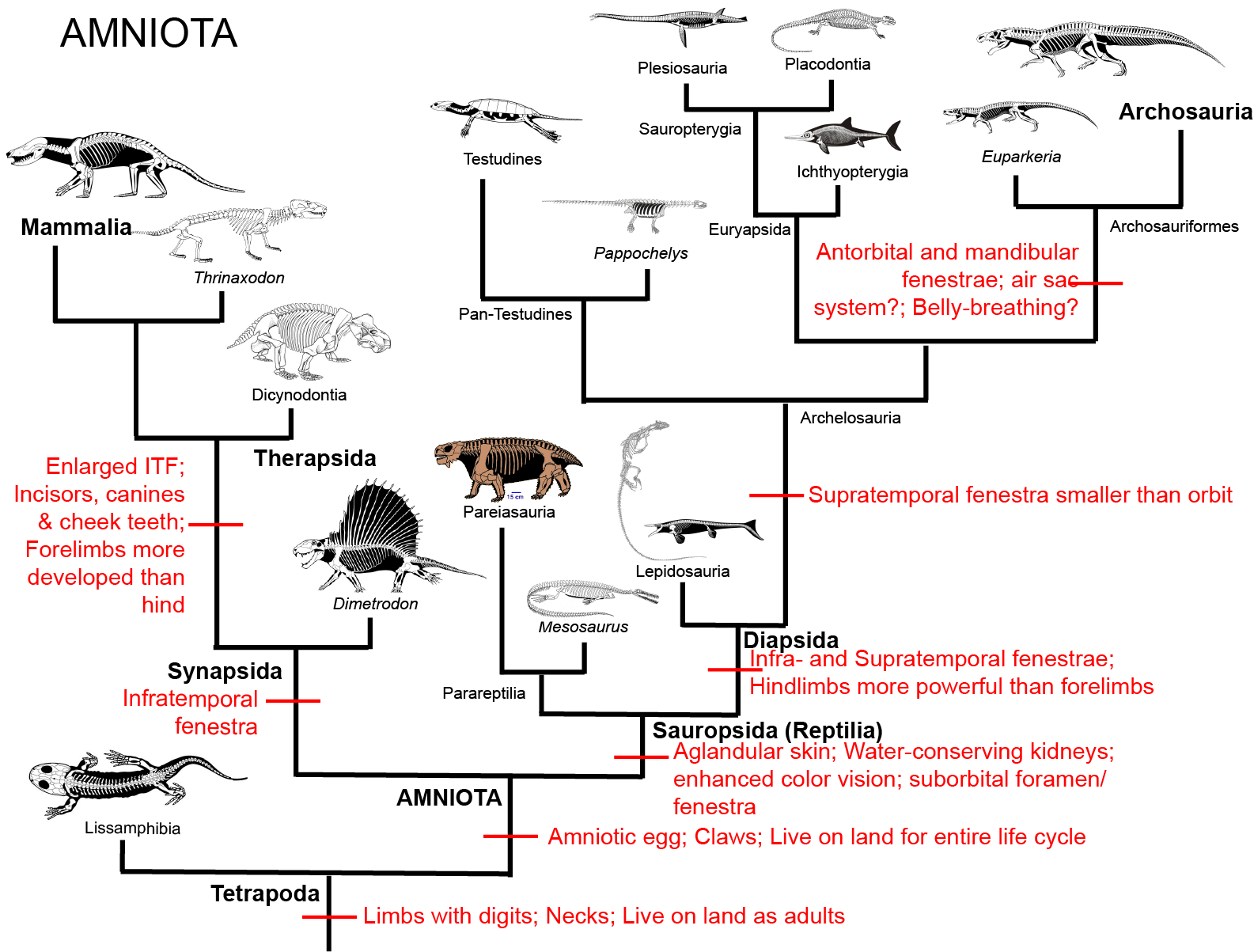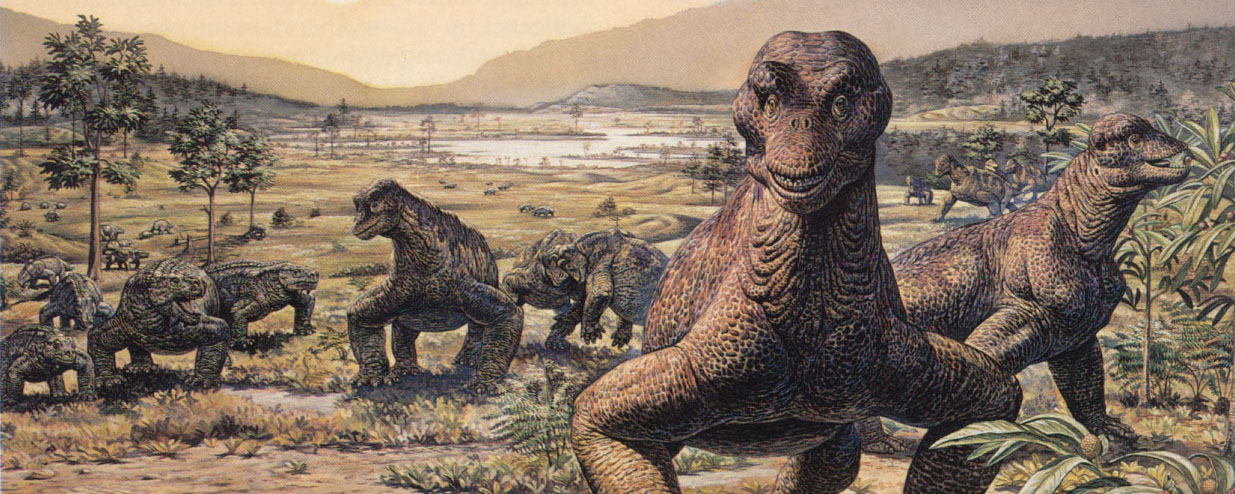


Key Points:
•Life emerged in the water, and it took a series of adaptations (defense against gravity and desiccation; new forms of respiration, reproduction, locomotion, and senses; etc.) for taxa to colonize the land.
•Among vertebrates, it was "amphibian"-grade tetrapods which partially made the transition to life on land, but only the amniotes that lived their entire life cycle on land.
•The amniotes had evolved a shelled egg, keratinized skin, and claws (among other traits) which allowed them to be successful at living on land.
•Different groups of amniotes radiated at different times: the first group were the basal members of the Synapsida (the lineage that contains mammals) in the Carboniferous and Early Permian; followed by their descendants (the Therapsida) in the Middle and Late Permian.
I. The Colonization of Land
Life on Earth first evolved in the seas over 3.5 billion years ago, and even today the majority of living things are aquatic. The terrestrial realm of land and air offers many challenges to organisms adapted to aquatic life:
The first organisms that spent at least sometime out of water were algae mats along the edges of seas and lakes (which are among the oldest fossils known!) But for over 3 billion years life was essentially limited to the water. By the early Paleozoic Era, the marine realm was as crowded with living things as the modern oceans, but the land was still mostly barren: perhaps some lichens and bacteria, but not much more.
Among the first fully terrestrial organisms were true primitive plants that had colonized land by the Silurian Period (443.4-419.2 Ma). (Some fossils show that they actually had colonized at least by the earlier Ordovician Period, but were apparently not widespread.) The terrestrial world offered the primitive plants mineral resources and plenty of more space (to collect sunlight!) than could be found in the crowded seas.
The first terrestrial animals were various types of arthropods (bugs, broadly defined): the ancestors of millipedes and centipedes, the earliest arachnids, and the ancestors of insects were established on land in the Silurian Period. These ate the early plants, and each other.
(Other groups, such as earthworms, other worms, snails, and so on colonized during this time.)
The ancestors of the dinosaurs (and us!) during this time were still entirely aquatic. Primitive vertebrates were all aquatic: in other words, they were fish. ("Fish" is simply the name for all vertebrates that aren't tetrapods; there are many diverse lineages of vertebrates other than the land ones!).
In the early part of the Devonian Period (419.2-358.9 Ma), the fish continued to diversify. This diversity included many sorts that lived in freshwater.
Freshwater has its own problems compared to sea water, but various types of fish evolved traits to deal with them:
So by the later part of the Devonian Period there were vertebrates which had a bony skeleton to support their bodies; bony limbs with wrists, ankles, and digits to push along on land or on the lakebed; lungs to breath air (but still had gills to breath in the water).
Many of these Late Devonian stegocephalians still lived their lives essentially only in the water (such as Acanthostega), and thus were essentially fish-with-fingers. Others (such as Ichthyostega) may have gotten most of their food from land. It was from these latter sort that the more fully terrestrial vertebrates--the Tetrapoda ("four footed ones"), would evolve.
During the early part of the Carboniferous Period (358.9-298.9 Ma) the early tetrapods became established. Unlike earlier stegocephalians, these had necks (that is, the skull was not attached to the scapula), which allowed them to bend their heads down to capture food on land. Like fish, these early tetrapods still laid their eggs in the water and their young (tadpoles) often had gills. As adults, though, many were more terrestrial.
In that way, the early tetrapods were "amphibians" in the broad sense of the term. However, these were often scaly-skinned (like fish), unlike the naked-skinned Lissamphibia (frogs, toads, salamanders, etc.: the modern clade of amphibians). Carboniferous and Permian (299-251 Ma) Period primitive tetrapods included a great diversity: snake-like forms; primarily aquatic boomerang heads; alligator-like forms; and many others. But even for those forms which spent most of their adult lives on land had to come back to the freshwater to reproduce.
During the Carboniferous, however, one group of tetrapods evolved an adaptation that allowed them to break free of the pond: the amniotic egg. Instead of being a "naked" egg laid in a pond or stream, the amniotic egg had:
In other words, tetrapods were now freed from the water. As such, the tetrapods with an amniotic egg did not have a larval ("tadpole") stage, and so they were terrestrial for their entire life cycle. This adaptation marks the evolution of the most successful clade of tetrapod, the Amniota:

Other than the amniotic egg, amniotes are also characterized by claws and the presence of an infratemporal fenestra. (Well, and a bunch of other traits, too, but we are not going into that level of detail in this 100-level class!)
II. Life on Land Before the Dinosaurs
Amniotes first appear in the later Carboniferous Period. At this time, many low-lying parts of the land were covered in vast coal swamps (so called because the buried remains of these swamps make up the majority of the coal deposits of the Northern Hemisphere). While the fish-eating tetrapods stayed near the ponds, the amniotes were free to pursue other prey further onto land. With access to this new environment, the amniotes underwent a series of adaptive radiations.
Amniotes divide into two major divisions:
The synapsids were the first group to radiate. The name "synapsid" refers to a condition where the skull had a complete infratemporal fenestra with a lowerbar but no supratemporal fenestra. However, it turns out that the "synapsid" skull condition is the basal state for Amniota. There are a bunch of other traits that unite the Synapsida, that these are outside the scope of this class.
During the Early Permian Epoch primitive synapsids radiated into many different forms, including:
These early synapsids would have had the sprawling stance found in primitive tetrapods in general. They almost certainly would have been "cold-blooded" (the ancestral state for vertebrates). So traditionally these animals have been considered "reptiles". However, they lack the shared derived features of reptiles (see below), and are instead simply primitive synapsids. (In traditional taxonomy, these were put in the group "Pelycosauria", but this is a paraphyletic group: all synapsids except for therapsids). New discoveries show that even early synapsids had some parental care.
The early synapsids evolved themselves into extinction: that is, they were replaced in the Middle and Late Permian Epoch by the Therapsida: the advanced synapsids. Once called the "mammal-like reptiles", they are not true reptiles. Instead, they are the advanced branch of the synapsid phylogeny. They differed from earlier synapsids by:
The Middle and Late Permian therapsids included:
Ancestrally, all vertebrates are cold-blooded (warm their bodies primarily using sunlight). However, some evidence suggests that the advanced therapsids of the Late Permian may have had elevated metabolisms (that is, were at least partially warm-blooded):
Additionally, some therapsids seem to have had parental care of the young, keeping them in burrows.
Sauropsids tended to be relatively rare in the Carboniferous and Permian Periods. Sauropsida is characterized by a number of particular skeletal features (which we aren't going to deal with here, as they are fairly technical). Modern sauropsids (and by inference, their concestor and all of its descendants) share a number of soft-tissue features:
A skeletal trait that has long been thought of as helpful in understanding sauropsid relationships, yet which recently turns out to be convergently evolved (or reversed) in many different lineages is the supratemporal condition. Once thought to be restricted to Sauria--the group uniting Lepidosauria (snakes, other lizards, and tuatara) and Archosauria (birds and crocs and their extinct kin)--and their close kin it is now known that the presence of the supratemporal fenestra (and thus the "diapsid" skull condition, where both the supra- and infratemporal fenestrae are present) evolves independently in several different sauropsid clades. In fact, the clade "Diapsida" as defined in the literature (all descendants of the concestor of the Carboniferous Petrolacosaurus and the lepidosaur-archosaur clade) turns out to include all known members of Sauropsida!
The relationships among Paleozoic and early Mesozoic sauropsids has gone through major revisions in the last few years. For example, it was once that that there was a clade (Parareptilia) which included most of the Permian and several Triassic reptiles. Now, however, the "parareptiles" are found to be polyphyletic.
Among the non-saurian sauropsids are:
For many years it was argued that turtles were a branch of "parareptile". And it is true that the oldest known animals more closely related to turtles than any other named group is a wide-bodied Permian form with broad ribs. New discoveries of this animal (Eunotosaurus) and of Triassic proto-turtles show that the turtle lineage is a type of saurian, however, and not "parareptiles" at all.
The classic old-style "Diapsida" comprises a clade known as Sauria. Saurians and their immediate outgroups possess:
During the late Paleozoic saurians were only a very minor part of the ecosystem.
In general, compared to typical Mesozoic and Cenozoic ecosystems, the late Paleozoic land vertebrates were smaller (few ox- or hippo-sized, none larger), slower (no real speed specialists), and close to the ground (only a few gliders and no powered fliers).
Some relevant videos:
